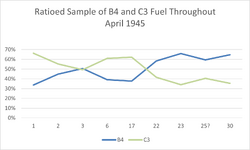Deleted member 68059
Staff Sergeant
- 1,056
- Dec 28, 2015
I think you missed "(economically)"I think this gets cause and effect wrong. For fertilizer and explosives you need ammonia which you get from the Haber-Bosch process. For HB you need nitrogen, which you can distill from the atmosphere, and hydrogen. Nowadays hydrogen is produced via steam reforming of natural gas, back then it was coal gasification.
Coal hydrogenation via the Bergius process also requires a source of hydrogen (again, coal gasification), but other than that Bergius is not a step in the HB process or vice versa.
Now it made logistical sense to co-locate (as well as a more attractive bombing target) the HB plants with the Bergius plants and hydrogen plants, then as now hydrogen transportation and storage is very tricky. But they could have dispersed them, with one hydrogen production plant for the HB plant and another separate one for the Bergius plant.
Last edited:

